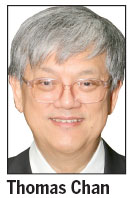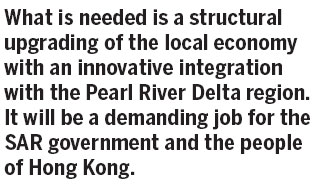Going north the way ahead
Updated: 2013-04-09 05:40
By Thomas Chan(HK Edition)
|
|||||||||
Hong Kong has never isolated itself as a closed economy and society. From the very beginning of its inception as a British colony, it has been purposely declared a free trade port, an entrepot between East and West, and more specifically between Guangzhou (and later Shanghai) and the overseas market. It has been relying on Guangzhou and its hinterland not only for exportable goods, but also for food, water and labor as well as capital, information and knowledge. This was the reason why before 1949, Hong Kong had not had a border control with the adjacent mainland areas, and why throughout its hundred-plus years of history it has maintained good relations with its neighbors even during the Cold War when the United States imposed economic sanctions.

Between the 1950s and 1970s when the Chinese mainland was closed by US sanctions and Hong Kong relied on local industrialization for its economic growth that made it a post-war economic miracle, trade flows had not stopped between Hong Kong and the mainland. The Canton Fair had relied on Hong Kong as the transit point for goods and merchants doing foreign trade with the mainland. Hong Kong's local industrialization has always been a transplanted one from the mainland, first the machinery, management, skill, knowledge and labor, and later labor and entrepreneurial talents from waves of immigration that have continued from the 1950s up to the present.
The development after the opening-up of the mainland since the 1980s has demonstrated the interdependence of Hong Kong with it. Transplanted industrialization has happened once again, albeit at a much larger scale but similarly export-oriented. Subsequently Hong Kong has reverted to its pre-1949 roles as entrepot and international financial center for the mainland, but again at a much larger scale and with greater complexity in business than before.
At present Hong Kong has practically de-industrialized and re-exports have a volume larger than the overall GDP of the local economy. In addition, Hong Kong has become more the shopping mall for increasingly well-off mainland residents and has the preferred universities for the crme de la crme of Chinese students. The daily number of people crossing the boundary amounts to over 400,000, making it the second-busiest cross-boundary traffic in the world. The intensified flows of people and goods have made the two places much more integrated than many within the same customs area. It is definitely easier to travel across the boundary now than before 1949, even when there was no boundary check and controls.
Economically Hong Kong is still a free trade port and has few obstacles against people flow. The Closer Economic Partnership Arrangement (CEPA) has reduced further institutional barriers against the trade of services that have been created because of the difference in institutions between the mainland and the British legacy in Hong Kong. Globalization and extensive market liberalization in the world have promoted harmonization, if not homogenization, of institutions. Both the mainland and Hong Kong should not be exceptions to these global trends.
At a time when the world is witnessing the formation of large economic blocs, the most visible of which is the European Union and the North American Free Trade Area, the mainland has recently been trying to catch up and has completed the free trade agreement (FTA) with ASEAN (Association of Southeast Asian Nations) countries. At present it is also actively negotiating the ASEAN+3 (China, Japan and South Korea).

Compared with Singapore, its archrival, Hong Kong is lagging behind. Singapore has already signed FTA with Japan, the EU and the US, in addition to many others. Hong Kong has only three FTAs with New Zealand, Chile and the Free Trade Association of Europe (Iceland, Liechtenstein, Norway and Switzerland), all of which are not its major trading partners, nor significant economic players in the world. If a larger free trade bloc of ASEAN+3 can be successfully completed in East and Southeast Asia, on a par with the many regional trade blocs in the world, Hong Kong will be marginalized and as such it would lose its important international role as a free trade port.
Hong Kong has lost the world's No 1 port accolade to Shanghai, Asia's busiest passenger airport to Beijing and its container port turnover is less than the combined sum of Guangzhou and Shenzhen container ports. Local GDP now is smaller than that of the Pearl River Delta region and retail sales last year were 60 percent of those in Guangzhou - including more than half of the sales to mainland visitors. Hong Kong's relative position in the world and in China has been declining and at a fast pace. It is the tens of thousands of mainland visitors and their purchasing power that sustain local economic growth. Without them and the not-so-visible sales of financial products (as well as properties) in Hong Kong to mainland residents, Hong Kong would have seen negative growth of its economy in recent years.
Any revival of Hong Kong's economy depends on how it makes the best use of its integration with the mainland economy, in particular the fast-growing Pearl River Delta region. It is not to subjugate the Hong Kong economy to the mainland, nor the abolition of "One Country, Two Systems". Either way will lose the unique competitiveness of Hong Kong vis--vis mainland cities. Yet, Hong Kong cannot survive without its economic interdependence with the mainland. What is needed is a structural upgrading of the local economy with an innovative integration with the Pearl River Delta region. It will be a demanding job for the SAR government and the people of Hong Kong, but without it Hong Kong does not have the means to compete with Guangzhou, or even Shenzhen.
The author is head of China Business Center, Hong Kong Polytechnic University.
(HK Edition 04/09/2013 page1)